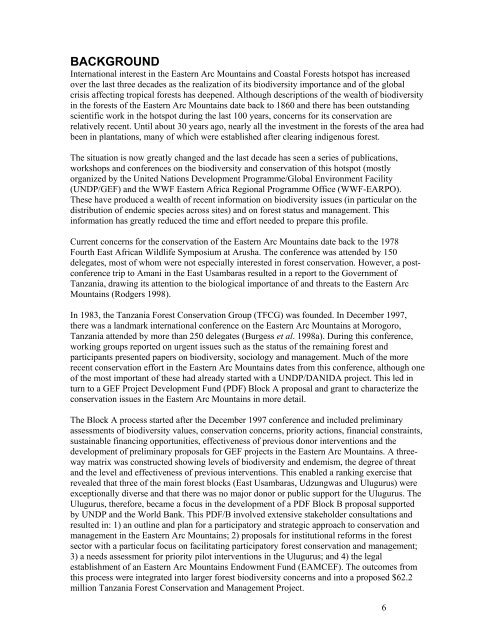Eastern Arc Mountains and Coastal Forests of Tanzania and Kenya ...
Eastern Arc Mountains and Coastal Forests of Tanzania and Kenya ...
Eastern Arc Mountains and Coastal Forests of Tanzania and Kenya ...
You also want an ePaper? Increase the reach of your titles
YUMPU automatically turns print PDFs into web optimized ePapers that Google loves.
BACKGROUNDInternational interest in the <strong>Eastern</strong> <strong>Arc</strong> <strong>Mountains</strong> <strong>and</strong> <strong>Coastal</strong> <strong>Forests</strong> hotspot has increasedover the last three decades as the realization <strong>of</strong> its biodiversity importance <strong>and</strong> <strong>of</strong> the globalcrisis affecting tropical forests has deepened. Although descriptions <strong>of</strong> the wealth <strong>of</strong> biodiversityin the forests <strong>of</strong> the <strong>Eastern</strong> <strong>Arc</strong> <strong>Mountains</strong> date back to 1860 <strong>and</strong> there has been outst<strong>and</strong>ingscientific work in the hotspot during the last 100 years, concerns for its conservation arerelatively recent. Until about 30 years ago, nearly all the investment in the forests <strong>of</strong> the area hadbeen in plantations, many <strong>of</strong> which were established after clearing indigenous forest.The situation is now greatly changed <strong>and</strong> the last decade has seen a series <strong>of</strong> publications,workshops <strong>and</strong> conferences on the biodiversity <strong>and</strong> conservation <strong>of</strong> this hotspot (mostlyorganized by the United Nations Development Programme/Global Environment Facility(UNDP/GEF) <strong>and</strong> the WWF <strong>Eastern</strong> Africa Regional Programme Office (WWF-EARPO).These have produced a wealth <strong>of</strong> recent information on biodiversity issues (in particular on thedistribution <strong>of</strong> endemic species across sites) <strong>and</strong> on forest status <strong>and</strong> management. Thisinformation has greatly reduced the time <strong>and</strong> effort needed to prepare this pr<strong>of</strong>ile.Current concerns for the conservation <strong>of</strong> the <strong>Eastern</strong> <strong>Arc</strong> <strong>Mountains</strong> date back to the 1978Fourth East African Wildlife Symposium at Arusha. The conference was attended by 150delegates, most <strong>of</strong> whom were not especially interested in forest conservation. However, a postconferencetrip to Amani in the East Usambaras resulted in a report to the Government <strong>of</strong><strong>Tanzania</strong>, drawing its attention to the biological importance <strong>of</strong> <strong>and</strong> threats to the <strong>Eastern</strong> <strong>Arc</strong><strong>Mountains</strong> (Rodgers 1998).In 1983, the <strong>Tanzania</strong> Forest Conservation Group (TFCG) was founded. In December 1997,there was a l<strong>and</strong>mark international conference on the <strong>Eastern</strong> <strong>Arc</strong> <strong>Mountains</strong> at Morogoro,<strong>Tanzania</strong> attended by more than 250 delegates (Burgess et al. 1998a). During this conference,working groups reported on urgent issues such as the status <strong>of</strong> the remaining forest <strong>and</strong>participants presented papers on biodiversity, sociology <strong>and</strong> management. Much <strong>of</strong> the morerecent conservation effort in the <strong>Eastern</strong> <strong>Arc</strong> <strong>Mountains</strong> dates from this conference, although one<strong>of</strong> the most important <strong>of</strong> these had already started with a UNDP/DANIDA project. This led inturn to a GEF Project Development Fund (PDF) Block A proposal <strong>and</strong> grant to characterize theconservation issues in the <strong>Eastern</strong> <strong>Arc</strong> <strong>Mountains</strong> in more detail.The Block A process started after the December 1997 conference <strong>and</strong> included preliminaryassessments <strong>of</strong> biodiversity values, conservation concerns, priority actions, financial constraints,sustainable financing opportunities, effectiveness <strong>of</strong> previous donor interventions <strong>and</strong> thedevelopment <strong>of</strong> preliminary proposals for GEF projects in the <strong>Eastern</strong> <strong>Arc</strong> <strong>Mountains</strong>. A threewaymatrix was constructed showing levels <strong>of</strong> biodiversity <strong>and</strong> endemism, the degree <strong>of</strong> threat<strong>and</strong> the level <strong>and</strong> effectiveness <strong>of</strong> previous interventions. This enabled a ranking exercise thatrevealed that three <strong>of</strong> the main forest blocks (East Usambaras, Udzungwas <strong>and</strong> Ulugurus) wereexceptionally diverse <strong>and</strong> that there was no major donor or public support for the Ulugurus. TheUlugurus, therefore, became a focus in the development <strong>of</strong> a PDF Block B proposal supportedby UNDP <strong>and</strong> the World Bank. This PDF/B involved extensive stakeholder consultations <strong>and</strong>resulted in: 1) an outline <strong>and</strong> plan for a participatory <strong>and</strong> strategic approach to conservation <strong>and</strong>management in the <strong>Eastern</strong> <strong>Arc</strong> <strong>Mountains</strong>; 2) proposals for institutional reforms in the forestsector with a particular focus on facilitating participatory forest conservation <strong>and</strong> management;3) a needs assessment for priority pilot interventions in the Ulugurus; <strong>and</strong> 4) the legalestablishment <strong>of</strong> an <strong>Eastern</strong> <strong>Arc</strong> <strong>Mountains</strong> Endowment Fund (EAMCEF). The outcomes fromthis process were integrated into larger forest biodiversity concerns <strong>and</strong> into a proposed $62.2million <strong>Tanzania</strong> Forest Conservation <strong>and</strong> Management Project.6
















